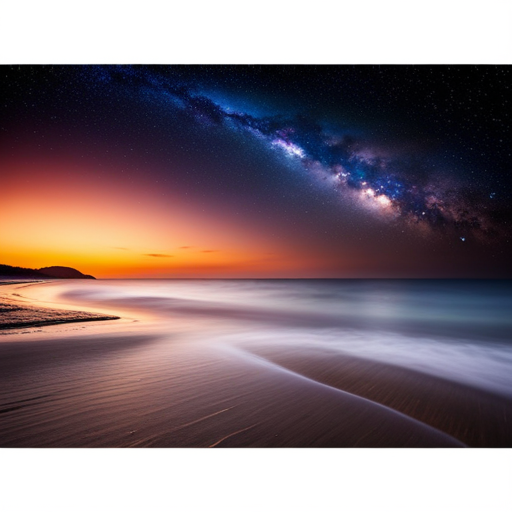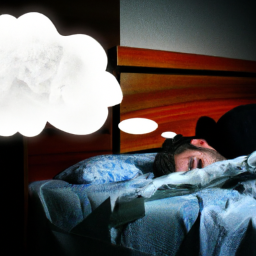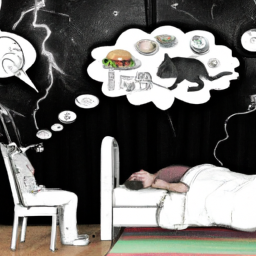Have you ever had the feeling of plunging into a surreal alternate reality while you sleep? I have. Vivid dreams, those captivating and immersive nocturnal experiences that feel almost real, have always intrigued me.
As I delve into the realm of dreams, I am compelled to explore the enigmatic nature of these vivid nocturnal wanderings and uncover their hidden meanings.
Vivid dreams possess a unique quality, as if reality and imagination intertwine seamlessly, blurring the boundaries of the conscious and unconscious mind. They can evoke emotions so vivid that they linger long after waking, leaving us to ponder their significance. But what do these dreams truly mean? What secrets do they hold?
In this article, we will embark on a journey through the labyrinthine landscapes of vivid dreams, untangling the threads of symbolism, exploring the science behind their occurrence, and discovering famous examples throughout history and literature.
We will also delve into the art of dream interpretation and analysis, providing tips for coping with nightmares and disturbing vivid dreams.
So, join me as we unravel the mysteries of these mesmerizing nocturnal visions and embrace the captivating world of vivid dreams.
Key Takeaways
- Vivid dreams provide insights into our subconscious thoughts and emotions.
- Different types of vivid dreams, such as lucid dreams, prophetic dreams, and nightmares, offer unique experiences and meanings.
- Sleep quality and emotional well-being impact the intensity of vivid dreams.
- Understanding dream symbolism and engaging with dream vividness can lead to self-awareness and personal growth.
Definition and Characteristics of Vivid Dreams
Having really vivid dreams means experiencing intense and lifelike visions while sleeping, allowing my imagination to wander freely through a realm of heightened sensations and emotions. Vivid dreams are characterized by their clarity, vividness, and the ability to recall them with great detail upon waking up. These dreams often involve a wide range of sensory experiences, such as vivid colors, sounds, tastes, and smells, making them feel incredibly realistic.
One of the defining features of vivid dreams is the presence of vivid dream symbols. These symbols can be objects, people, or situations that hold personal or universal meaning. They often represent our unconscious thoughts, desires, fears, or emotions, and can provide valuable insights into our psyche. Analyzing these symbols can help us gain a deeper understanding of ourselves and our experiences.
Furthermore, the impact of vivid dreams on mental health cannot be underestimated. They can serve as a mirror, reflecting our subconscious thoughts and emotions. By exploring and processing these dreams, we can gain insight into unresolved issues, traumas, or conflicts that may be affecting our well-being. This self-reflection can lead to personal growth, healing, and enhanced self-awareness.
Understanding the types of vivid dreams and their significance can provide valuable insights into our inner world. In the next section, I’ll discuss the different types of vivid dreams and delve deeper into their meanings and interpretations.
Types of Vivid Dreams
Lucid dreams are a fascinating phenomenon where the dreamer becomes aware that they’re dreaming and can actively participate in the dream. This type of dream allows for a sense of control and can be an exciting experience for those who can achieve it.
Prophetic dreams, on the other hand, are dreams that seem to predict future events or provide insights into the future, though the scientific validity of these dreams is still a subject of debate.
Nightmares, the third type of vivid dream, are characterized by intense fear, distress, and negative emotions, often waking the dreamer up in an anxious state.
These types of dreams can provide valuable insights into the workings of the human mind and offer a window into the subconscious.
Lucid Dreams
Experiencing a lucid dream is like being a master painter in a world where reality becomes a blank canvas. It is a unique state of consciousness where the dreamer is aware that they are dreaming and can actively participate in shaping the dream narrative. Lucid dreaming techniques, such as reality checks and keeping a dream journal, can help individuals increase their frequency of lucid dreams. These dreams offer a fascinating opportunity to explore the depths of our subconscious mind and understand the hidden meanings behind dream symbolism. To provide a deeper understanding of lucid dreams, let’s delve into the following table:
| Lucid Dreaming Techniques | Dream Symbolism |
|---|---|
| Reality Checks | Unconscious desires |
| Dream Journal | Emotional processing |
| Meditation | Personal growth |
| Mnemonic Induction of Lucid Dreams (MILD) | Creative problem-solving |
Lucid dreams can be a powerful tool for personal growth and self-discovery. Moving on to the next section about ‘prophetic dreams’, these extraordinary experiences offer glimpses into an unknown realm of possibilities.
Prophetic Dreams
Prophetic dreams offer a glimpse into a realm of possibilities, providing insights and foreshadowing events that may come to pass. These dreams have a spiritual significance and are often seen as messages from a higher power.
They can be vivid and realistic, making the dreamer feel as though they’re experiencing the future firsthand. Prophetic dreams can be distinguished from regular dreams by their accuracy and the strong emotions they evoke. They can provide guidance and warnings, helping individuals make important decisions or avoid potential dangers.
Some people believe that prophetic dreams are a way for the subconscious mind to communicate with the conscious mind, while others attribute them to supernatural or psychic abilities. Regardless of the explanation, these dreams have fascinated and intrigued people throughout history.
Transitioning into the subsequent section about nightmares, these terrifying dreams offer a stark contrast to the enlightening nature of prophetic dreams.
Nightmares
Prepare yourself for a heart-pounding journey into the realm of nightmares, where your worst fears come to life and haunt your every thought. Nightmares, as the table below illustrates, are vividly terrifying dreams that can have a significant psychological impact on individuals.
| Column 1 | Column 2 | Column 3 | Column 4 |
|---|---|---|---|
| Nightmares | Vivid and terrifying | Psychological | Haunt individuals |
| dreams | impact | every thought |
Nightmares can leave us feeling anxious, fearful, and emotionally drained upon waking. They often stem from real-life stressors or traumatic experiences, reflecting our deepest fears and anxieties. These intense dreams can disrupt our sleep patterns and affect our overall well-being.
Understanding the possible meanings and interpretations of vivid dreams is crucial in unraveling the mysteries of our subconscious mind. From exploring the symbolism behind these nightmares to delving into the underlying emotions they evoke, deciphering their messages can offer valuable insights into our inner psyche.
Transitioning into the subsequent section about the possible meanings and interpretations of vivid dreams, we can delve deeper into the fascinating realm of dream analysis.
Possible Meanings and Interpretations of Vivid Dreams
When you have exceptionally vivid dreams, your mind delves into a realm of subconscious symbolism, revealing hidden desires and unresolved emotions. These vivid dreams can offer profound insights into our innermost thoughts and feelings, providing a window into our subconscious mind. The psychological significance of vivid dreams lies in their ability to bring to the surface what may be buried deep within our psyche.
Through vivid dreams, our subconscious mind communicates with us in a language of symbols and metaphors. These dreams can serve as a mirror, reflecting our fears, desires, and unresolved conflicts. They offer a unique opportunity for self-reflection and exploration of our deepest thoughts and emotions.
The psychological community recognizes the importance of vivid dreams in understanding our inner world. Psychoanalysts, for example, utilize dream analysis as a tool to uncover hidden meanings and gain insight into a person’s psyche. By examining the symbols and themes present in vivid dreams, psychologists can help individuals uncover and work through unresolved issues.
Understanding the possible meanings and interpretations of vivid dreams can provide valuable self-awareness and personal growth. It allows us to better understand ourselves and the complex workings of our subconscious mind. By exploring these dreams, we can gain valuable insights into our deepest desires, fears, and unresolved emotions.
Moving forward, it’s important to consider the factors that influence the vividness of dreams and how they can impact our overall well-being.
Factors that Influence the Vividness of Dreams
Immerse yourself in the depths of your subconscious mind and explore the kaleidoscope of emotions that influence the vividness of your dreams. The intensity of our dreams is influenced by a variety of factors, each playing a crucial role in shaping our dreamscapes.
Here are three key factors that can impact the vividness of our dreams:
-
Sleep quality: The quality of our sleep directly affects the intensity of our dreams. When we experience deep, uninterrupted sleep, our dreams tend to be more vivid and lifelike. On the other hand, restless or fragmented sleep can result in less memorable and hazy dreams.
-
Emotional state: Our emotional well-being has a significant impact on the vividness of our dreams. Strong emotions, such as stress, anxiety, or joy, can heighten the intensity of our dreams, making them more vivid and memorable.
-
External stimuli: External factors, such as noise, temperature, or light, can influence the intensity of our dreams. For example, a loud noise or a bright light during sleep can trigger vivid and intense dream experiences.
Understanding these factors that influence dream intensity can help us unravel the mysteries of our subconscious mind. As we delve deeper into the science behind vivid dreams, we can uncover the fascinating mechanisms that give rise to these immersive nocturnal experiences.
The Science Behind Vivid Dreams
During REM sleep, the brain is highly active, and this increased brain activity contributes to the vividness of dreams.
Neurotransmitters and hormones play a crucial role in regulating this brain activity during REM sleep, with serotonin and norepinephrine levels decreasing, and acetylcholine levels increasing.
Additionally, the process of dream recall and memory formation is intricately connected, as the brain consolidates and stores information from the dreams during REM sleep, which can later be recalled upon waking.
Brain Activity during REM Sleep
REM sleep, known for its intense brain activity, is responsible for the incredibly vivid dreams that captivate our minds.
Extensive REM sleep research has shown that the brain is highly active during this stage, with increased neural firing and communication. These patterns of brain activity closely resemble those seen during wakefulness, suggesting that the brain is processing information and creating vivid dream experiences.
Additionally, studies have found that emotions play a significant role in dream vividness. Emotionally charged experiences are more likely to be incorporated into dreams, leading to more intense and realistic dream scenarios. This connection between emotions and dream vividness highlights the intricate relationship between our waking experiences and our dream world.
Transitioning to the next section on neurotransmitters and hormones, it’s important to understand the role they play in modulating brain activity during REM sleep.
Neurotransmitters and Hormones
Neurotransmitters and hormones work together to regulate brain activity and enhance the enjoyment of dream experiences.
During REM sleep, the brain releases various neurotransmitters such as serotonin, acetylcholine, and dopamine, which play a crucial role in dream formation and analysis.
Serotonin, known as the ‘feel-good’ neurotransmitter, helps to regulate mood and emotions during dreams, while acetylcholine is responsible for enhancing memory formation and critical thinking.
Dopamine, on the other hand, is involved in the reward and pleasure centers of the brain, making dreams more enjoyable and vivid.
Additionally, hormones like cortisol and melatonin also influence dream content and intensity.
Understanding the intricate relationship between neurotransmitters, hormones, and dream analysis and symbolism can provide valuable insights into the interpretation of dream experiences.
As we delve into the next section on dream recall and memory formation, we can further explore the mechanisms behind the fascinating world of dreams.
Dream Recall and Memory Formation
To truly understand the intricacies of dream recall and memory formation, you must actively engage with the processes that govern the encoding, consolidation, and retrieval of dream content within your own mind.
Dreams serve as a window into our subconscious, allowing us to explore the depths of our creativity. They often contain symbolic elements that can be analyzed and interpreted to gain insight into our thoughts and emotions. Dream symbolism is a fascinating area of study that reveals the hidden meanings behind the images and events in our dreams.
Additionally, the vividness of our dreams plays a crucial role in how well we remember them. Techniques for enhancing dream vividness can help us unlock the full potential of our dream experiences, allowing us to delve deeper into our subconscious and uncover the mysteries of our own minds.
Techniques for Enhancing Dream Vividness
Dream journaling is a technique I use to enhance the vividness of my dreams. By writing down my dreams immediately upon waking, I’m able to capture the details and emotions experienced during the dream. This helps me to remember and recall them more vividly.
Reality checks and lucid dreaming techniques are also important in enhancing dream vividness. By regularly questioning my reality throughout the day and practicing techniques to become aware that I’m dreaming while in a dream, I’m able to have more control over my dreams and make them more vivid.
Finally, meditation and visualization exercises have been shown to increase dream recall and vividness. By incorporating these practices into my daily routine, I’m able to enter a relaxed and focused state of mind. This enhances the clarity and intensity of my dreams.
Dream Journaling
Keeping a dream journal is a fantastic way to recall and document the vivid dreams experienced during sleep. By writing down the details of my dreams immediately upon waking, I’m able to capture the essence of the dream and remember it more clearly.
This process also helps me identify recurring themes or symbols in my dreams, allowing me to explore their potential meanings. Additionally, keeping a dream journal can be a helpful tool for practicing lucid dreaming techniques. By regularly recording my dreams, I can become more aware of the patterns and signs that indicate I’m dreaming.
This increased awareness can then be used to perform reality checks and initiate lucid dreaming techniques, ultimately leading to more vivid and immersive dream experiences.
Reality Checks and Lucid Dreaming Techniques
When it comes to lucid dreaming, it’s important to regularly perform reality checks to increase your chances of becoming aware in your dreams. Reality check techniques serve as a way to question the reality of your surroundings, helping you recognize when you are in a dream state.
One common reality check technique is looking at your hands and counting your fingers. In dreams, your hands may appear distorted or have more or fewer fingers than usual. Another technique is trying to push your finger through the palm of your other hand. In dreams, your finger may pass through your hand effortlessly.
These reality checks can help train your mind to question reality, increasing the likelihood of having a lucid dream. By incorporating reality checks into your daily routine, you can enhance your lucid dreaming induction.
Now, let’s transition into the subsequent section about meditation and visualization exercises.
Meditation and Visualization Exercises
After discussing reality checks and lucid dreaming techniques, it’s time to explore another method that can help enhance the vividness of dreams: meditation and visualization exercises.
These practices involve training the mind to focus and create vivid mental imagery. By incorporating visualization techniques into a regular meditation practice, individuals can develop a heightened ability to imagine and control their dream experiences. Additionally, mindfulness exercises can promote a state of heightened awareness, making it easier to recognize and engage with the dream world.
Scientific research has shown that these practices can improve dream recall and increase the clarity and intensity of dreams.
Now, let’s delve into tips for coping with nightmares and disturbing vivid dreams, as understanding how to manage these experiences is crucial for a restful night’s sleep.
Tips for Coping with Nightmares and Disturbing Vivid Dreams
To handle nightmares and hauntingly vivid dreams, it’s helpful to practice relaxation techniques before bed. Taking the time to calm your mind and body can reduce anxiety and promote better sleep. One technique that I find helpful is deep breathing. By inhaling slowly through my nose and exhaling through my mouth, I can feel the tension in my body melting away. Another tip for managing anxiety is to engage in a calming activity before bed, such as reading a book or listening to soothing music.
Understanding dream symbolism can also be useful in coping with disturbing dreams. Dreams often contain hidden meanings that can provide insight into our subconscious thoughts and emotions. Keeping a dream journal can help in deciphering these symbols and unraveling the messages that our dreams are trying to convey. By analyzing the themes and symbols that appear in our dreams, we can gain a deeper understanding of ourselves and our inner struggles.
Transitioning into the next section about dream interpretation and analysis, it’s important to remember that dreams are complex and multifaceted. By exploring the deeper meanings behind our dreams, we can uncover valuable insights into our psyche and gain a greater understanding of ourselves.
Dream Interpretation and Analysis
After discussing tips for coping with nightmares and disturbing vivid dreams, it’s important to delve into the realm of dream interpretation and analysis.
Dreams have long fascinated psychologists and researchers, as they provide a unique insight into the workings of the human mind. Dream symbolism is a key aspect of this field, as it focuses on the idea that dreams have a psychological significance beyond their surface-level content. By analyzing the symbols and themes present in our dreams, we can gain a deeper understanding of our subconscious thoughts, desires, and fears.
Dream interpretation involves deciphering the meaning behind these symbols and uncovering the hidden messages within our dreams. It requires careful analysis and consideration of personal experiences, emotions, and cultural influences. For example, dreaming about flying may represent a desire for freedom, while dreaming about being chased could symbolize a fear of confrontation or avoidance.
Understanding the psychological significance of our dreams can be a valuable tool for personal growth and self-reflection. By exploring the layers of meaning within our dreams, we can gain insights into our own psyche and make connections to our waking life.
Transitioning into the subsequent section about famous examples of vivid dreams in history and literature, it becomes evident that dreams have had a profound impact on humanity throughout the ages.
Famous Examples of Vivid Dreams in History and Literature
Throughout history and literature, vivid dreams have captivated humanity with their mind-bending and life-altering experiences. Famous dreamers from all walks of life have shared their encounters with these extraordinary dreams, leaving an indelible mark on the collective imagination.
From the surreal visions of Salvador Dali to the prophetic dreams of Abraham Lincoln, vivid dreams have played a significant role in shaping the creative landscape of our world.
The impact of vivid dreams on creativity cannot be overstated. These immersive experiences often serve as a wellspring of inspiration for artists, writers, and musicians. They provide a unique platform for exploring the depths of the subconscious mind, unlocking hidden talents and unearthing innovative ideas. The vividness of these dreams enhances the creative process, infusing it with heightened emotions, vivid imagery, and profound symbolism.
Embracing and appreciating the enigmatic nature of vivid dreams allows us to tap into a well of infinite possibilities. By delving into the depths of our dream world, we gain access to a realm where reality and fantasy intertwine, where the boundaries of what is possible dissolve.
It is through this exploration and appreciation that we can fully embrace the transformative power of vivid dreams, and unlock the limitless potential they hold for personal growth and creative expression.
Embracing and Appreciating the Enigmatic Nature of Vivid Dreams
Immerse yourself in the mysterious and captivating realm of vivid dreams, where reality and fantasy intertwine, and experience the infinite possibilities that await within.
Vivid dreams have always fascinated me, as they provide a glimpse into the depths of our subconscious minds. While many may find these dreams unsettling or puzzling, I’ve learned to appreciate the unknown and embrace the enigmatic nature of vivid dreams.
One aspect that I find particularly intriguing is exploring dream symbolism. Dreams often contain symbols that can have personal meaning to the dreamer. For example, a dream about flying could represent a desire for freedom or a sense of empowerment. By delving into the symbolism of our dreams, we can gain valuable insights into our innermost thoughts and emotions.
Appreciating the unknown is an essential part of understanding vivid dreams. Instead of dismissing them as mere fantasies, we can approach them with a sense of curiosity and wonder. The vividness of these dreams allows us to engage with them on a deeper level, exploring the intricate details and emotions they evoke.
Embracing and appreciating the enigmatic nature of vivid dreams opens up a world of possibilities. By exploring dream symbolism and delving into the unknown, we can gain a better understanding of ourselves and our subconscious minds. So, let’s embrace the captivating realm of vivid dreams and unlock the mysteries they hold.
Frequently Asked Questions
Are vivid dreams the same as lucid dreams?
Vivid dreams and lucid dreams are not the same. While vivid dreams are characterized by intense sensory experiences during sleep, lucid dreams are when one becomes aware that they’re dreaming and can control the dream.
Lucid dreaming has numerous benefits, such as enhancing creativity, problem-solving abilities, and self-awareness. Techniques to induce lucid dreaming include reality checks, keeping a dream journal, and practicing meditation.
Mastering lucid dreaming can truly unlock the potential of our subconscious mind.
Can vivid dreams be a sign of a sleep disorder?
Vivid dreams can indeed be a sign of a sleep disorder. Stress has been found to have an impact on the vividness of dreams. When we’re stressed, our dreams can become more intense and vivid.
Additionally, there’s a relationship between vivid dreams and mental health disorders. People with conditions like anxiety, depression, and post-traumatic stress disorder often report having more vivid and emotionally charged dreams.
Understanding the connection between vivid dreams and sleep disorders can help in diagnosing and treating these conditions.
How can I remember my vivid dreams better?
Improving dream recall can be achieved through various techniques. One interesting statistic is that keeping a dream journal can increase dream recall by up to 50%.
To remember vivid dreams better, I recommend setting a consistent sleep schedule, practicing relaxation techniques before bed, and using mnemonic devices to enhance memory.
Additionally, learning about dream symbolism can help in interpreting the meaning behind vivid dreams, providing insight into our subconscious thoughts and emotions.
Do certain medications or substances affect the vividness of dreams?
Certain medications and substances can indeed affect the vividness of dreams. Alcohol and caffeine, for example, can disrupt the normal sleep cycle and reduce the amount of REM sleep, which is when dreams occur. This can lead to less intense and less memorable dreams.
On the other hand, some antidepressants, such as selective serotonin reuptake inhibitors (SSRIs), have been known to increase dream intensity. This may be due to the way these medications interact with neurotransmitters in the brain.
Can vivid dreams be influenced by external factors, such as sleep environment or lifestyle choices?
Sleep environment and lifestyle choices can indeed impact the vividness of our dreams. Factors such as a comfortable bed, quiet room, and optimal temperature can create a conducive sleep environment, promoting more vivid dreams.
Similarly, lifestyle choices like consuming certain foods, exercising regularly, and managing stress levels can also influence dream intensity. By prioritizing a sleep-friendly environment and making healthy lifestyle choices, we can enhance the vividness of our dreams and potentially experience more meaningful and immersive dream experiences.
Conclusion
In conclusion, vivid dreams offer a fascinating glimpse into the complexities of our subconscious minds. They provide us with an opportunity for self-reflection and exploration through their detailed and immersive nature. By understanding the various types, meanings, and factors that influence the vividness of our dreams, we can gain valuable insights into our emotions, experiences, and desires.
Although the science behind vivid dreams is still not fully understood, we can employ techniques to cope with disturbing dreams and embrace the enigmatic nature of this phenomenon. So, let’s embrace the mystery and appreciate the beauty of our vivid dreams.










